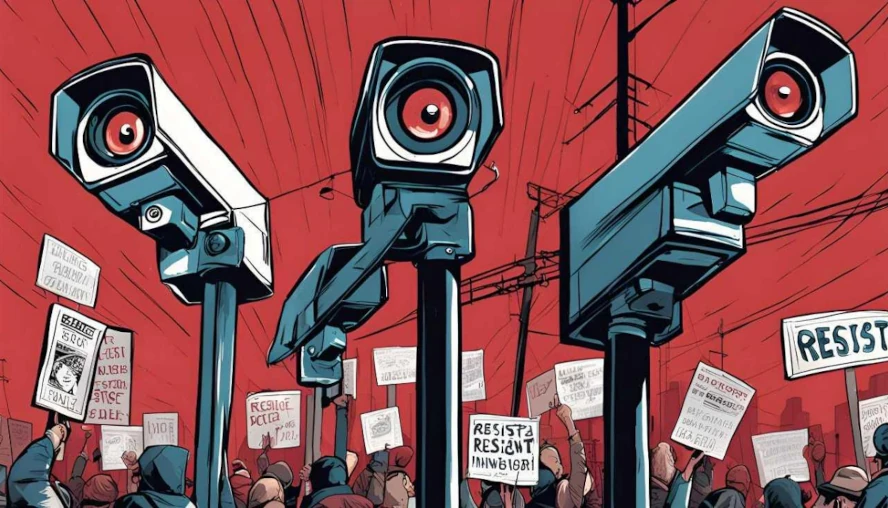Resistance is Futile: An Analysis of “Resistance Money, a Philosophical Case for Bitcoin”, Chapter 6
August 13, 2024 – by untraceable

“Resistance Money, a Philosophical Case for Bitcoin”, the book which has recently captured the minds of many Bitcoiners by promising to reveal Bitcoin as a tool for resistance and freedom. The authors, Andrew M Bailey, Bradley Rettler, and Craig Warmke tell readers: “Bitcoin is resistance money, empowering its users to resist authoritarians, inflation, surveillance, censorship, and financial exclusion.” But beneath this inspiring rhetoric lies a misleading narrative.
I believe Bitcoin began with the ability to resist authoritarians and surveillance, but those abilities eroded with time like a building weathering decades of wind and rain with no maintenance from the builders. Decentralization isn’t enough to resist authoritarians, surveillance, censorship and financial exclusion. Privacy is the crucial missing ingredient.
I was tagged on Twitter (X) on the release of the book “Resistance Money” asking for my opinion on it. I made my opinion quite clear: If Bitcoin is not capable of offering simple and intuitive privacy for even the most technologically illiterate, then it is a butterfly caught in the net of financial censorship, oppression, and government control. Without privacy, Bitcoin is not truly censorship resistant, and it possesses little ability to resist anything.
Knowing my stance on Bitcoin’s privacy, Andrew M. Bailey kindly offered to email me the only chapter which had any chance of changing my mind. The chapter which would address my most significant reservations. Chapter 6: “Privacy in Public”. The chapter that specifically addresses Bitcoin’s privacy, or lack thereof.
This isn’t your typical book review. I have read Chapter 6 of “Resistance Money”. Therefore this is a review of that chapter of the book. In my opinion, Chapter 6 should be the most important chapter of the book, regarding a topic that without which the remainder of the book has no foundation for its claims. The entire premise of the book rests on Chapter 6’s shoulders.
We must always aim to challenge what we think we know, lest we risk losing the ability to innovate. Maybe there is a good argument to be made on how Bitcoin can still work as “Resistance Money” despite announcing to the world your every move in a public transparent ledger.
Before I get into my thoughts on Chapter 6 of Resistance Money, I want to recount some history. Recent history that will put into perspective why privacy is of paramount importance for the ability of a financial instrument such as Bitcoin to resist oppression and enable freedom for the user.
A Real World test of Bitcoin’s ability to Resist Oppression
The year is 2022. The COVID “pandemic” is well underway. Lockdowns are in full-swing in many parts of the world under the guise of preventing the spread of the virus. Governments declare national emergencies giving themselves power to spend more money and enact special “temporary” laws which are normally beyond their reach.
The rules are different everywhere, but for many this means: Small businesses have been forced to cease operations and its owners gone bankrupt. Traveling is essentially impossible unless you are a privileged politician or person of power and influence. People are not allowed outside except to exercise within a limited distance from their home. Thanksgiving and Christmas are canceled. Surgical or cloth masks are required everywhere even though they are shown to have highly questionable efficiency.
Some parts of the world are more authoritarian than others. In Australia, people are taken from their homes and placed in COVID Quarantine camps against their will. A stay for which they will later be required to pay from their own pockets. In China, people are physically locked in their apartment buildings and homes.
In many western countries of the world, those who do not get the experimental COVID injections, are not allowed to: travel, go to the hospital, watch a movie at the theater, go to restaurants, visit family members, buy groceries, or work. People lose the ability to provide for their families if they resist. If they resist, they lose their livelihoods.

Canadian Freedom Convoy, March 2022
Naturally, groups of people arose to resist this tyranny and overreach of power. In Canada, the Freedom Convoy arose to protest the vaccine mandates and border blockades bankrupting businesses, disrupting families, and wrecking the economy. Protesters occupied the downtown core of Ottawa and other major Canadian cities and stated that they would not leave until all COVID-19 restrictions and mandates, trucking related and beyond, were repealed.
The Canadian Government froze identified protesters’ bank accounts to cut-off funding for the protests. The overreach of power during the COVID “pandemic” was the perfect catalyst for Bitcoin to showcase its power to resist oppression. This is what Bitcoin was made for. It was Bitcoin’s time to shine. Bitcoin was the resistance. Or so some people thought.
As the government continued to exert its control over citizens’ lives, it became clear that Bitcoin’s decentralized nature was not enough to shield its users from authoritarian measures. Its limitations were revealed.
“Bitcoin’s a system of public ledger, so all transactions on the network are visible to everyone. This includes, of course, the authorities that want to track them down. The Ontario Provincial Police and Royal Canadian Mounted Police (RCMP) ordered banks and crypto exchanges to block any transactions from crypto wallets tied to the truckers.”
Bitcoin donated to the Freedom Convoy was tracked, blacklisted, and seized (1, 2, 3). To add insult to injury, identified recipients of Bitcoin donations also had their bank accounts frozen in addition to having Bitcoin confiscated by the RCMP. During this crucial moment, Bitcoin displayed no more ability to resist government overreach than the traditional banking system. This wasn’t a failure of custody. It was a failure of privacy. Even if the distribution of the Bitcoin to the protesters had been accomplished with no trusted third parties, the recipients of the Bitcoin would have been surveilled at every step of the way. Their addresses would have been blacklisted and blocked at exchanges, and eventually, they would have been compelled to relinquish the donated Bitcoin. This was facilitated by the fact that Bitcoin publicly announces every transaction detail with full transparency.
As you will notice from the sources provided above, Monero addresses tied to Freedom Convoy donations were also sanctioned. But due to Monero’s strong privacy, sanctioning a Monero address is meaningless. No Monero donations to the Freedom Convoy were seized, nor do we know how much Monero (if any) was donated to protestors.
So this brings us back to the book, “Resistance Money”. Having witnessed the colossal failure of Bitcoin to resist centralized control in a real world setting, what insights can “Chapter 6, Privacy in Public” offer that we don’t already know?
“Chapter 6, Privacy in Public”
Chapter 6 is divided into sub-chapters. Sub-chapters 6.1 through 6.3 set the stage by explaining to the reader what privacy is, why its important, and mentioning Bitcoin’s cypherpunk roots.
“We must defend our own privacy if we expect to have any. . . . People have been defending their own privacy for centuries with whispers, darkness, envelopes, closed doors, secret handshakes, and couriers. The technologies of the past did not allow for strong privacy, but electronic technologies do”
Read the Cypherpunk Manifesto by Eric Hughes >
In summary, the start of the chapter states that
Privacy helps preserve relationships.
Privacy serves as a check on public institutions.
Privacy reduces unwanted exposure.
Privacy protects freedom of thought, and freedom of expression.
Privacy is a power of selective disclosure.
It goes on to explain the importance of financial privacy specifically in sub-chapter 6.4. “For what we do with our money shows, rather than tells, who we really are.”
Dimensions of Financial Privacy
In Sub-Chapter 6.5 the author explores the four dimensions of financial privacy, privacy in acquisition, privacy in spending, forward, and backward privacy. “…sadly, bitcoin does not automatically provide users with significant financial privacy. The ledger is public, and all amounts, destinations, and sources are available for inspection by all.”
In this section of the chapter we learn that Bitcoin lacks Privacy in all four dimensions.
Bitcoin lacks Privacy in Acquisition,
“Bitcoin’s public ledger limits its privacy assurances, especially given how most people acquire bitcoin. For many years now, most have acquired bitcoin from an online exchange. Exchanges allow users to trade their digital currencies – fiat or crypto – for bitcoin. But popular exchanges require users to cough up their personal information: your full name, a government-issued ID, bank information, address, and maybe even a personal photograph. So when you withdraw your bitcoin, the exchange can tie your unique UTXO to the personal information they’ve collected”
Bitcoin lacks forward privacy,
“Bitcoin has much poorer forward privacy. Your nosy neighbor might love to know how you spend your money. So he hatches a plan for you to mow his law for bitcoin. Once he gets your bitcoin address for the payment, he can track future transactions from that address. He can also google every address where you send bitcoin”
Bitcoin lacks privacy in spending,
“Suppose you have a basket of UTXOs, each unrelated to each other and to your identity. To buy a watch, say, your wallet combines some smaller quantity UTXOs into a single transaction, much like we might combine bills and coins to buy a coffee. Doing so connects previously unrelated UTXOs. Congratulations: now any observer has good reason to believe that a single entity controlled the smaller UTXOs.”
and Bitcoin lacks backward privacy.
“You can fairly easily leak your past transaction history with bitcoin.
Spend bitcoin to an address, and anyone can tell exactly where the bitcoin came from. This makes your own transaction history vulnerable to blockchain sleuths. As we’ll explain, the sleuths can then decipher, with some probability, the sources of your UTXOs, the sources of those sources, and so on.
It gets worse. Unlike glitter, security footage, DNA, a fingerprint, or the scent of cologne, the bitcoin ledger doesn’t fade with time. So even if you meticulously acquired and disposed of bitcoin, a single mistake years later could expose your financial history to the world.”
Now that we understand how Bitcoin falls short on all four dimensions of financial privacy (acquisition, spending, forward, and backward), let’s dive into what arguments the book makes about why Bitcoin can still be considered “Resistance Money” despite these limitations. How do the authors attempt to convince the reader that Bitcoin can resist oppression while at the same time divulging to would-be oppressors everything we do financially?
An attempt to address Bitcoin’s shortcomings with Coinjoin and Lightning
Coinjoin and the Lightning Network are the two most commonly suggested ways to gain privacy when using Bitcoin. “Resistance Money” describes Coinjoin and the Lightning Network as answers to Bitcoin’s lack of privacy at the protocol level.
Lightning
Lightning’s ephemerality is one of the primary claims to providing user privacy. Emphemeral – meaning lightning transactions are not recorded on a public ledger. Instead, routing nodes are the only ones privy to what funds travel through them. Each node only has information about which payments were routed through them. But here’s the catch – even if Lightning transactions aren’t stored on a public ledger, they’re still vulnerable to being reconstructed by anyone with access to node data. With enough information, it’s possible for observers to map out transaction graphs.

Largest Lightning nodes by liquidity as of Aug. 13, 2024
Due to the centralizing design of the Lightning network, few nodes hold a majority of the liquidity on the network. Of the few large nodes holding the most liquidity, many of them belong to legal entities. The question then becomes, How many of these nodes do you believe are under legal obligation to report data to authorities?
Binance for example, the third largest Lightning node, tells us themselves:
“over 60 professionals…[work] to detect, monitor, and prevent [financial crimes]. They collaborate closely with…law enforcement agencies, reporting and assisting in the investigation of suspicious actors and transactions.” (link)
Under an adversarial mindset, we must assume that all large lightning nodes operated by legal entities collaborate with law enforcement or chain analysis companies directly to gather information and surveil LN users. Ephemerality in the Lightning Network is therefore not a privacy solution. Lightning might provide privacy, but you can not and should never depend on Lightning for privacy. Lightning was designed as a scaling tool for Bitcoin, not as a privacy tool. Therefore any privacy considerations in the design of Lightning come as an afterthought rather than a priority. Lightning is a great tool for fast and cheap transactions, but is not a reliable tool for privacy.
One analysis of the Lightning Network from 2021 concludes:
“Bitcoin’s base layer does not have any privacy guarantees and neither does Lightning. There are ways to attempt to hide amongst the activity of the network, but it’s no guarantee. Sizable actors can attack and reveal private channels that are an extension of the main graph. From there, the flow of funds across the network should be considered public knowledge.”
Moreover, even private channels in Lightning are often not private.
Coinjoin
Coinjoin provides forward privacy (and only forward privacy), but it doesn’t alter the underlying issue of Bitcoin’s non-fungibility. It is obvious to an observer when a UTXO participates in a coinjoin, meaning that UTXO can be discriminated against in the same way tainted Bitcoin are discriminated against. When trying to deposit Coinjoined Bitcoin into an exchange, your coins are likely to get frozen – and you’ll probably need to prove their origin as well as provide personal identification. There are many such real world examples of this exact thing happening, some of which can be found at Bitcoin’s Fungibility Graveyard.
The authors of Resistance Money highlight several other significant drawbacks to Coinjoin, including:
Coinjoin requires enough participants,
Coinjoining only works with equally sized inputs, (e.g., 0.01 BTC)
Coinjoins are time-intensive and not suitable for urgent transactions
Counterparties can refuse transactions with a coinjoin history (as I already described above)
User error is a risk. Committing a mistake such as consolidating coinjoined outputs can undo all the privacy gained.
In addition to these issues, coinjoin services have become largely inaccessible after the arrest of the Samourai Wallet developers in April 2024, and discontinuation of Wasabi Wallet’s coinjoin coordinator in May 2024. This has made it more difficult for users to access coinjoin services. Currently available coinjoin implementations are inherently centralized because of their reliance on a coordinator to facilitate the collaborative transactions.
In light of this, I do not believe that Coinjoin or the Lightning Network are reliable avenues through which someone can find refuge from oppression or authoritarianism. When privacy is delegated to the application layer, or a completely different network altogether, the result is an inferior solution with a high degree of complexity which is prone to user error and only a minority of people will make an attempt to use, therefore making it trivial to target and discriminate against those within a system who opt for some privacy.
Comparisons of Cash and Bitcoin with a dash of Intellectual Dishonesty
From sub-chapter 6.5.5 onwards the book begins exploring the authors’ perceived privacy weaknesses of cash transactions, and then perplexingly equating those perceived privacy weaknesses in cash to Bitcoin’s complete lack of privacy.
So what are the weaknesses of cash as perceived by “Resistance Money”?
Claim One:
“Cash’s physicality means that CCTV monitors can track your movements in the convenience store. Interested observers could match scanned images of your spent bills with your image in the video feed. Serial numbers, while not tracked exhaustively, are tracked more often than we might guess – in automated checkout devices, for example. Overall, cash provides significant but incomplete control over what financial information leaks to counterparties or observers. So while cash is a popular and effective tool for financial privacy, it is imperfect in both its privacy guarantees and its usefulness.”
Lets address this claim: It is unlikely that many (if any) CCTV cameras have the ability to zoom in clearly enough to read the serial numbers or match the image of a specific bill any customer spends. This paragraph suggests that serial numbers are “tracked more often than we might guess” but offers no supporting evidence as to how often serial numbers are tracked, who tracks them, or how the tracking is accomplished.
Even assuming an observer somehow knows the serial number of a spent bill, there is no central database tracking cash transactions. There is no history attached to cash, and no further trail for the observer to follow. While it is unlikely that an observer knows which specific bill you owned, it is downright impossible for the observer to know how you came into possession of said bill, or how it will be spent in the future.
Claim Two:
“A bill’s forward anonymity set is the group of its potential direct recipients. So if an observer knows you spent cash in a given neighborhood and that only 30 shops accept cash there, the forward anonymity set has 30 members.”
To address this claim we have to acknowledge that it is not a guarantee that an observer can know when someone spends cash, nor where it is spent. An observer might know that there are 30 shops that accept cash in a given neighborhood, but cash transactions occur with private individuals as well. One may respond to a Facebook Market ad or another online ad to purchase a household appliance. One may pay a business partner or friend for their share of the lunch they had last week. There are many more possible private cash transaction participants who are not part of the assumed “anonymity set” (30 shops accepting cash in a neighborhood).
Even if a hypothetical observer is monitoring your every move 24/7 and happens to see you enter one of these 30 cash-accepting shops, cash retains its plausible deniability. Not all shops have surveillance cameras, and not all people who enter shops necessarily purchase something from the shop. This contrasts sharply with Bitcoin’s complete lack of privacy: when spent, we know exactly when it was spent, how much was spent, which address the Bitcoin was sent to, as well as where the Bitcoin moves in the future. There is no such plausible deniability with Bitcoin. All transactions are recorded on a public transparent blockchain for eternity. Giving an adversary an unlimited amount of time to connect your transactions to your identity, if they hadn’t already.
Parody: Cash and Bitcoin
From the authors’ perceived weaknesses of privacy in cash transactions, the authors conclude the following in sub-chapter 6.7 (Parity: Cash and Bitcoin):
“We can now unveil a parity thesis: cash and bitcoin create similar opportunities for privacy, with similar drawbacks and limitations. This contention will turn out to have important normative consequences. If the privacy cash offers is desirable, so, too, is the privacy bitcoin offers.”
It goes on to say…
“Using bitcoin does not guarantee much privacy. But under best practices, bitcoin offers cash-like privacy. Since cash is itself not perfectly private, bitcoin does not offer perfect privacy either, even under best practices.”
These conclusions are as puzzling as they are shocking. The authors overstate the privacy weaknesses of cash, while downplaying the differences between cash transactions and Bitcoin transactions, thus equating them. While it is true that there are drawbacks to using cash, mainly due to their physical and spacial characteristics, cash-like privacy is the golden standard of privacy that digital assets aim to emulate. Therefore to go on and claim that Bitcoin is “cash-like” when in fact it is completely transparent, and its most popular means of gaining privacy are inaccessible (coinjoin), and not dependable (lightning) is utterly absurd. The parity thesis in “Resistance Money” seems more like a contrived argument than a genuine comparison.
The Meticulously Crafted Illusion of Resistance in Bitcoin… is Fading
Despite the constant propaganda from Bitcoin Evangelists that Bitcoin is “Freedom Money”, “Resistance Money” and such, we can observe that the public opinion on Bitcoin is shifting. Not long ago, most people believed Bitcoin was fully anonymous. Some still do, but I would say they are now in the minority.
Now that we have banks, ETFs, and presidential candidates to the state apparatus itself jumping onboard the Bitcoin wagon, its becoming increasingly difficult to deny that Bitcoin’s resistance is an illusion, and the illusion is fading at an accelerated pace. Bitcoin has been subsumed into the system is was meant to replace.
Recently we heard from prominent people such as Peter Thiel, who is (or at least was) a big proponent of Bitcoin and believed in its potential as a revolutionary technology, say:
Peter Thiel (@peterthiel) on Bitcoin and Crypto:
— ᴜɴᴛʀᴀᴄᴇᴀʙʟᴇ (@DontTraceMeBruh) June 29, 2024
"When people in the FBI tell me that they much rather criminals use Bitcoin than $100 bills, it suggests that maybe its not quite working the way its supposed to."
Maybe you need a #Monero. It works the way its supposed to. pic.twitter.com/6JKQfRJBYX
“When people in the FBI tell me that they much rather criminals use Bitcoin than $100 bills, it suggests that maybe its not quite working the way its supposed to.”
-Peter Thiel
Similarly, we heard from Tucker Carlson:
"Until I can move country to country with Bitcoin, and not be tracked... until I can exercise that with this currency, it's less meaningful to me."@TuckerCarlson what you're looking for is #Monero. Fungible, private, and untraceable digital cash.https://t.co/hCOKHOyZmM pic.twitter.com/u9bYRvyKzY
— ᴜɴᴛʀᴀᴄᴇᴀʙʟᴇ (@DontTraceMeBruh) July 31, 2024
“Until I can move country to country with Bitcoin, and not be tracked… until I can exercise that with this currency, it’s less meaningful to me.”
-Tucker Carlson
There is also Edward Snowden who has warned Bitcoiners about the perils of Bitcoin’s complete transparency for years. There are many more such examples of people coming to the realization that Bitcoin doesn’t actually work as they expected, the way it should. That Bitcoin isn’t private, isn’t cypherpunk, isn’t freedom money or resistance money, and it isn’t censorship resistant. The way Hal Finney put it, Bitcoin is designed to harm, not help, individual privacy.
“(Be aware that there are other proposals for “electronic money” which are not nearly so protective of individuals’ privacy. Chaum’s proposals are intended to preserve the privacy attributes of cash, so the term “digital cash” is appropriate. But other electronic replacements for cash not only lack its privacy, but would actually facilitate computer monitoring by putting more detailed information into databases, and by discouraging the use of cash. If you see a proposal for an electronic money system, check to see whether it has the ability to preserve the privacy of financial transactions the way paper money does today. If not, realize that the proposal is designed to harm, not help, individual privacy.)”
-Hal Finney, Protecting Privacy with Electronic Cash, 1993
In Closing…
“Bitcoiners” are enamored with the idea of freedom, of resisting oppression and making the world a better place. It is a just cause to fight for. A captivating notion that inspires and recruits others to your cause. The reality is that the idea that Bitcoin offers dissenters refuge and safety from Big Brother’s watchful eye is a vestige of Bitcoin’s humble beginnings.
Bitcoin did in fact once stand to liberate and empower its users, but the oppressors innovated, while Bitcoin stagnated. Multiple privacy enhancing technologies were proposed for the Bitcoin protocol over the years (Proposed Bitcoin Privacy Improvements), but none of them materialized on the protocol level, and only a few of them materialized on the application layer (coinjoin, silent payments).
Today, Bitcoin more accurately resembles a digital Panopticon. “The concept [of a Panopticon] is to allow all prisoners of an institution to be observed by a single corrections officer, without the inmates knowing whether or not they are being watched.”
The mere possibility that someone may be watching your actions is enough to alter your behavior. The goal of a Panopticon is just this. “If the prisoners of the panopticon prison could be seen but never knew when they were watched, the prisoners would need to follow the rules.”
I believe “Resistance Money” is intended for two types of readers: those who already fervently believe that Bitcoin is Resistance Money and don’t need convincing, and those who are unfamiliar with Bitcoin and/or adversarial environments and unable to critically evaluate the validity of the authors’ claims. “Resistance Money” is meant to exploit readers’ confirmation biases and reinforce their previously held misunderstandings/delusions.

Just use the spoon.
In conclusion, to describe Bitcoin as “Resistance Money” would be like describing a fork as “The perfect utensil for eating soup”. You most certainly can eat soup with a fork, but the process will be ineffective, slow, and frustrating. If you want to eat soup, use a spoon, and if you want the ability to resist authoritarians, inflation, surveillance, censorship, and financial exclusion, use a money that protects users’ privacy. Optimally, something that is fungible and private-by-default, whether thats Gold, Silver, Goldbacks, or Monero.
by untraceable – August 13, 2024
Buy untraceable a coffee, send XMR to:
8341oirGEbL9R2G7514b53AktSvokRTf8SQmKC2Y7QWMF1AoCaynTHkXN86Tx5BAfh343Umxng6rYVW22z7cacCdErt1LDc

